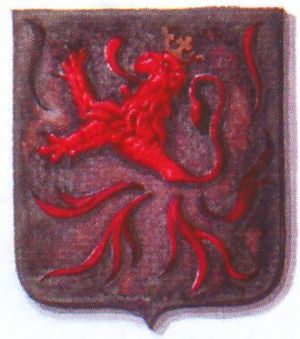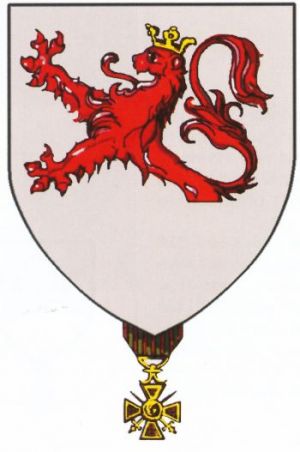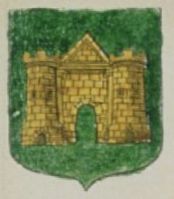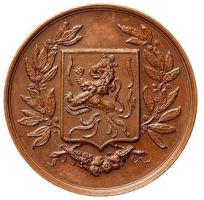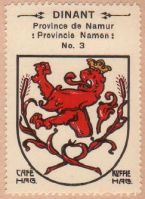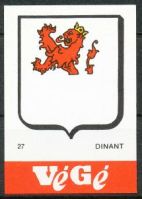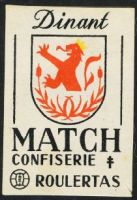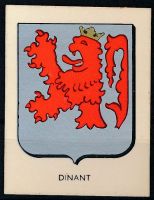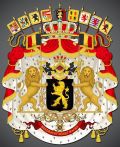Dinant: Difference between revisions
Knorrepoes (talk | contribs) No edit summary |
Knorrepoes (talk | contribs) m (Text replacement - "''' :" to "''':") |
||
| (25 intermediate revisions by the same user not shown) | |||
| Line 1: | Line 1: | ||
{| | {| class="wikitable" | ||
| | |- style="vertical-align:top;" | ||
| | |[[File:dinant1.jpg|center|300 px|alt=Blason de {{PAGENAME}}/Arms (crest) of {{PAGENAME}}]]<center>The arms from 1840</center>[[File:dinant.jpg|center|300 px|alt=Blason de {{PAGENAME}}/Arms (crest) of {{PAGENAME}}]]<center>The arms from 1927/1977</center> | ||
| | |||
<center>''' {{uc:{{PAGENAME}}}} '''</center><br> | |||
'''Country''': Belgium [[File:Belgium.jpg|60 px|right]]<br><br><br> | |||
'''Province''': <br>[[Namur (province)|Namur]][[File:namurp.jpg|60 px|right]]<br><br><br> | |||
'''Additions:''' | |||
* 1964 Anseremme | |||
* 1964 [[Bouvignes-sur-Meuse]] | |||
* 1964 Dréhance | |||
* 1977 Falmagne | |||
* 1977 Falmignoul | |||
* 1977 Foy-Notre-Dame | |||
* 1977 Furfooz | |||
* 1977 Lisogne | |||
* 1977 Sorinnes | |||
* 1977 Thynes | |||
<br> | |||
{{#display_map:50.2609,4.9123|width=250|height=250|zoom=7}} | |||
|} | |||
{| class="wikitable" | |||
|+Official blazon | |||
|- | |||
|'''French''' | |||
| | |||
*(1840) D'argent,à un lion naissant de gueules couronné d'or, entourné de joncs de gueules. | *(1840) D'argent,à un lion naissant de gueules couronné d'or, entourné de joncs de gueules. | ||
*(1927) D'argent au lion naissant de gueules, couronné d'une couronne d'or à 3 fleurons. L'écu orné extérieurement d'un bijou de la croix de guerre française, muni de son ruban et mouvant de la pointe. | *(1927) D'argent au lion naissant de gueules, couronné d'une couronne d'or à 3 fleurons. L'écu orné extérieurement d'un bijou de la croix de guerre française, muni de son ruban et mouvant de la pointe. | ||
*(1977) D'argent au lion issant de gueules, couronné d'une couronne d'or à trois fleurons, l'écu orné de la croix de guerre française, munie de son ruban et mouvant de la pointe. | *(1977) D'argent au lion issant de gueules, couronné d'une couronne d'or à trois fleurons, l'écu orné de la croix de guerre française, munie de son ruban et mouvant de la pointe. | ||
|- | |||
|'''English''' | |||
| blazon wanted | |||
|} | |||
===Origin/meaning=== | |||
The arms were granted on December 22, 1840 changed on December 7, 1927 and confirmed on August 19, 1977. | The arms were granted on December 22, 1840 changed on December 7, 1927 and confirmed on August 19, 1977. | ||
Dinant was an important fortress city already in early medieval times. The oldest known seals date from the late 14<sup>th</sup> century and show a tower and a bridge over the Meuse river. In 1399 a new seal showed a city with three towers, the local patron saint and the patron saint of the State of Liège, to which the city at the time belonged. On the middle tower a small shield was seen, with a demi-lion. A later seal, known since 1466, shows St. Perpète, the local patron saint, holding a shield with the lion. Coloured images are known from the 16<sup>th</sup> century and the arms have not changed since. | Dinant was an important fortress city already in early medieval times. The oldest known seals date from the late 14<sup>th</sup> century and show a tower and a bridge over the Meuse river. In 1399 a new seal showed a city with three towers, the local patron saint and the patron saint of the State of Liège, to which the city at the time belonged. On the middle tower a small shield was seen, with a demi-lion. A later seal, known since 1466, shows St. Perpète, the local patron saint, holding a shield with the lion. Coloured images are known from the 16<sup>th</sup> century and the arms have not changed since. | ||
In 1840 the arms were granted with a red lion and | In 1840 the arms were granted with a red lion and red rushes in silver, this was corrected in 1927, with the addition of the French War Cross. | ||
The origin of the lion is not clear. It has been speculated that the arms are derived from the arms of the oldest Lords of Dinant. | The origin of the lion is not clear. It has been speculated that the arms are derived from the arms of the oldest Lords of Dinant. | ||
| Line 33: | Line 49: | ||
Finally it has been speculated that the lion is derived from the arms of the Counts, later Dukes, of Limburg. | Finally it has been speculated that the lion is derived from the arms of the Counts, later Dukes, of Limburg. | ||
===Image gallery=== | |||
| | <gallery widths=250px heights=200px perrow=0> | ||
| | File:Dinantgo.jpg|alt=Blason de Dinant/Arms (crest) of Dinant|The arms in the Armorial Gorrevod (1460) | ||
File:Dinanth.jpg|alt=Blason de Dinant/Arms (crest) of Dinant|The arms in Hozier (1696)<br> (for Dinan-sur-Meuse) | |||
File:Dinantc.jpg|alt=Blason de Dinant/Arms (crest) of Dinant|The arms on a 19th century token | |||
File:dinant.hagbe.jpg|alt=Blason de Dinant/Arms (crest) of Dinant|The arms in the [[Koffie Hag Belgium|Koffie Hag/Café Hag albums]] +/- 1930 | |||
File:2036.wi2.jpg|alt=Blason de Dinant/Arms (crest) of Dinant|The arms on a Dutch [[Willem II]] cigar band | |||
File:027.vgb.jpg|alt=Blason de Dinant/Arms (crest) of Dinant|The arms on a [[VéGé (matchbox labels)|Végé]] match label | |||
File:Dinant.rou.jpg|alt=Blason de Dinant/Arms (crest) of Dinant|The arms on a [[Roulertas|Roulertas Confiserie]] label | |||
File:Dinant.bhb.jpg|alt=Blason de Dinant/Arms (crest) of Dinant|The arms of a [[Bobeka - Belgian arms|trade card]] | |||
</gallery> | |||
[[Civic Heraldry Literature - Belgium|'''Literature''']]: Servais, 1955 | |||
{{be}} | |||
{{media}} | {{media}} | ||
[[Category:Belgian Municipal Arms D]] | [[Category:Belgian Municipal Arms D]] | ||
Latest revision as of 08:35, 16 June 2024
|
Country: Belgium Province: Namur Additions:
|
| French |
|
| English | blazon wanted |
Origin/meaning
The arms were granted on December 22, 1840 changed on December 7, 1927 and confirmed on August 19, 1977.
Dinant was an important fortress city already in early medieval times. The oldest known seals date from the late 14th century and show a tower and a bridge over the Meuse river. In 1399 a new seal showed a city with three towers, the local patron saint and the patron saint of the State of Liège, to which the city at the time belonged. On the middle tower a small shield was seen, with a demi-lion. A later seal, known since 1466, shows St. Perpète, the local patron saint, holding a shield with the lion. Coloured images are known from the 16th century and the arms have not changed since.
In 1840 the arms were granted with a red lion and red rushes in silver, this was corrected in 1927, with the addition of the French War Cross.
The origin of the lion is not clear. It has been speculated that the arms are derived from the arms of the oldest Lords of Dinant.
Another story deals with the battle of Steppes in 1214, where the troops of Liège, especially from Dinant, fought the army of the Dukes of Brabant. During the battle St. Lambert, patron saint of Liège, appeared in the sky. This gave power to the forces of Liège and they defeated the Brabant forces, thereby cutting the banner of the Duke of Brabant in half. The arms of Brabant show a golden lion on a black field. Ever since the city of Dinant used the demi-lion....
Finally it has been speculated that the lion is derived from the arms of the Counts, later Dukes, of Limburg.
Image gallery
The arms in the Koffie Hag/Café Hag albums +/- 1930
The arms on a Dutch Willem II cigar band
The arms on a Végé match label
The arms on a Roulertas Confiserie label
The arms of a trade card
Literature: Servais, 1955
Belgium heraldry portal
This page is part of the Belgium heraldry portal |
Heraldry of the World |
|
Civic heraldry:
|
Other heraldry: |
Contact and Support
Partners:
Your logo here ?
Contact us
© since 1995, Heraldry of the World, Ralf Hartemink 
Index of the site
[[Category:Granted 1840]
[[Category:Granted 1927]
[[Category:Granted 1977]
